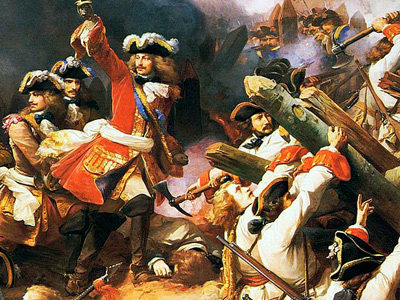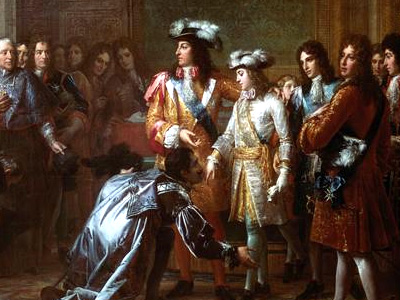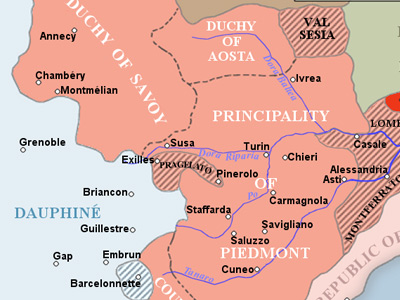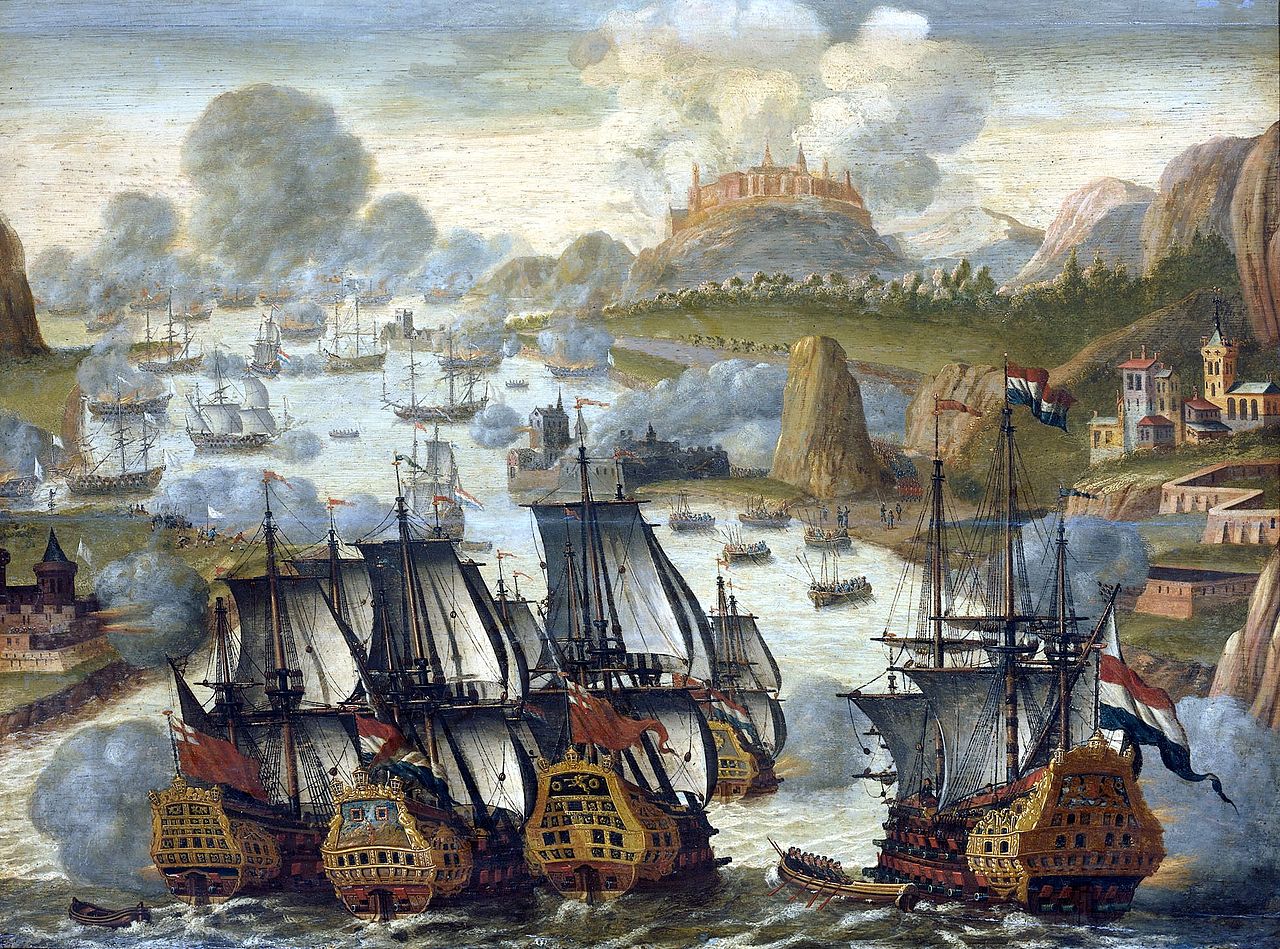War of the Spanish Succession (1702–1715)
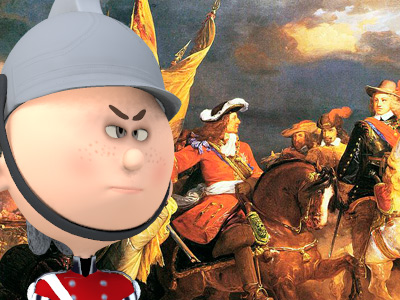
Grand Alliance Falters
Believing that Louis XIV was only stalling for time in order to recuperate his army, the ministry in London prepared to act vigorously on all fronts in 1709, hoping to draw the French back to the negotiating table. Central to both sides was the situation in Flanders. Here, Villars replaced Vendôme as commander of the French army and set about building a new defensive line from Aire to Douai (the Lines of Cambrin, or la Bassée, later extended) to block the line of advance from Lille to Paris. Due to the harshness of the previous winter and the scarcity of stores and provisions, Marlborough had initially recoiled from a full-scale invasion of France The Kingdom of France is the historiographical name or umbrella term given to various political entities of France in the medieval and early modern period. It was one of the most powerful states in Europe since the High Middle Ages. It was also an early colonial power, with possessions around the world. Colonial conflicts with Great Britain led to the loss of much of its North American holdings by 1763. The Kingdom of France adopted a written constitution in 1791, but the Kingdom was abolished a year later and replaced with the First French Republic. in preference to a conservative policy of siege warfare.
The Kingdom of France is the historiographical name or umbrella term given to various political entities of France in the medieval and early modern period. It was one of the most powerful states in Europe since the High Middle Ages. It was also an early colonial power, with possessions around the world. Colonial conflicts with Great Britain led to the loss of much of its North American holdings by 1763. The Kingdom of France adopted a written constitution in 1791, but the Kingdom was abolished a year later and replaced with the First French Republic. in preference to a conservative policy of siege warfare.
The Allies invested Tournai in July (the citadel did not fall till 3 September), before moving to attack Mons. Given a free hand from Louis XIV to save the city Villars, commanding perhaps 75,000 men, entrenched his army centred around the tiny village of Malplaquet. Confident that one last set-piece battle would result in the final destruction of the main French army and force Louis XIV to accept peace on Allied terms, Marlborough and Eugene, leading some 86,000 men, accepted the challenge and attacked the French position on 11 September. The Battle of Malplaquet was nominally a victory for the Allies, but a stern French defence and faults in the execution of the battle-plan prevented the Allies from winning decisively, and they suffered major losses. Although Mons subsequently fell in October, Villars and his co-commander Boufflers, had kept the French army intact.
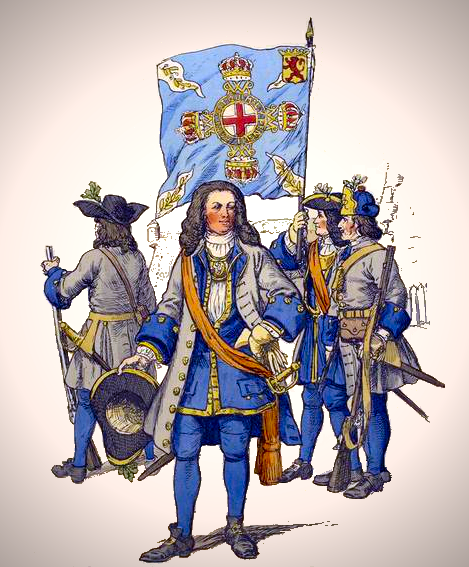
Infantry of the Dutch States Army. A musketeer (left), two ensigns (centre), grenadier (right)
The Allies were now lodged in the northern French provinces depriving Louis XIV of vital resources, but Villars' resistance had provided a boost to French morale. There was also French success in Spain in 1709: Alicante's citadel fell in April, and on 7 May the Marquis of Bay defeated Fronteira and Galway at the Battle of La Gudina on the Portuguese border. However, Louis XIV's greatest advantage lay in his enemy's political disunity, exacerbated as it was by the appalling Allied losses at Malplaquet (particularly the Dutch The Dutch Republic was a confederation that existed from 1579, during the Dutch Revolt, to 1795. It was a predecessor state of the Netherlands and the first fully independent Dutch nation state. Although the state was small and contained only around 1.5 million inhabitants, it controlled a worldwide network of seafaring trade routes. The income from this trade allowed the Dutch Republic to compete militarily against much larger countries. It amassed a huge fleet of 2,000 ships, initially larger than the fleets of England and France combined.) and the strategic indecisiveness of the battle. The Tories – whose Land Tax was funding the war – sought to make political gain by demonstrating that the Whigs and their friends at the Bank of England were benefiting from the ongoing conflict to the detriment of their compatriots. But there was also anger from the Dutch who, since April, had been pressing British ministers to accept their latest Barrier project. Talks had reached deadlock, but in August the Dutch had learnt of the secret territorial and commercial concessions the Habsburgs had yielded Britain
The Dutch Republic was a confederation that existed from 1579, during the Dutch Revolt, to 1795. It was a predecessor state of the Netherlands and the first fully independent Dutch nation state. Although the state was small and contained only around 1.5 million inhabitants, it controlled a worldwide network of seafaring trade routes. The income from this trade allowed the Dutch Republic to compete militarily against much larger countries. It amassed a huge fleet of 2,000 ships, initially larger than the fleets of England and France combined.) and the strategic indecisiveness of the battle. The Tories – whose Land Tax was funding the war – sought to make political gain by demonstrating that the Whigs and their friends at the Bank of England were benefiting from the ongoing conflict to the detriment of their compatriots. But there was also anger from the Dutch who, since April, had been pressing British ministers to accept their latest Barrier project. Talks had reached deadlock, but in August the Dutch had learnt of the secret territorial and commercial concessions the Habsburgs had yielded Britain The Kingdom of Great Britain was a sovereign country in Western Europe from 1 May 1707 to the end of 31 December 1800. The state was created by the 1706 Treaty of Union and ratified by the Acts of Union 1707, which united the kingdoms of England (which included Wales) and Scotland to form a single kingdom encompassing the whole island of Great Britain and its outlying islands, with the exception of the Isle of Man and the Channel Islands.; concessions at odds with the Treaty of Grand Alliance which had promised an equal division of the Spanish spoils. To appease their allies the Godolphin ministry now proposed its own concessions. By the Barrier Treaty of 29 October Townshend, without consulting Vienna, promised the Dutch an extensive Barrier fortress system, as well as commercial advantages in the Spanish Netherlands and an equal share of any advantages secured from Spain's Empire
The Kingdom of Great Britain was a sovereign country in Western Europe from 1 May 1707 to the end of 31 December 1800. The state was created by the 1706 Treaty of Union and ratified by the Acts of Union 1707, which united the kingdoms of England (which included Wales) and Scotland to form a single kingdom encompassing the whole island of Great Britain and its outlying islands, with the exception of the Isle of Man and the Channel Islands.; concessions at odds with the Treaty of Grand Alliance which had promised an equal division of the Spanish spoils. To appease their allies the Godolphin ministry now proposed its own concessions. By the Barrier Treaty of 29 October Townshend, without consulting Vienna, promised the Dutch an extensive Barrier fortress system, as well as commercial advantages in the Spanish Netherlands and an equal share of any advantages secured from Spain's Empire The Spanish Empire was a colonial empire governed by Spain and its predecessor states between 1492 and 1976. One of the largest empires in history, it was the first to usher the European Age of Discovery and achieve a global scale, controlling vast territory. It was one of the most powerful empires of the early modern period, reaching its maximum extent in the 18th century.; the Treaty also granted the Dutch Upper Guelders, to which the Prussians laid claim. In return, the States General offered concessions of their own, primarily to provide armed help in repelling any future foreign attempt to overthrow the Protestant succession in Great Britain. From the outset, however, Joseph I, Charles III, and the Tories who saw the Dutch primarily as commercial rivals, considered the agreement prejudicial to their own economic and strategic interests.
The Spanish Empire was a colonial empire governed by Spain and its predecessor states between 1492 and 1976. One of the largest empires in history, it was the first to usher the European Age of Discovery and achieve a global scale, controlling vast territory. It was one of the most powerful empires of the early modern period, reaching its maximum extent in the 18th century.; the Treaty also granted the Dutch Upper Guelders, to which the Prussians laid claim. In return, the States General offered concessions of their own, primarily to provide armed help in repelling any future foreign attempt to overthrow the Protestant succession in Great Britain. From the outset, however, Joseph I, Charles III, and the Tories who saw the Dutch primarily as commercial rivals, considered the agreement prejudicial to their own economic and strategic interests.
The Grand Alliance had failed to make the decisive breakthrough in 1709, but Louis XIV was far from confident: his finances were in a mess and the famine lingered. At Geertruidenberg from March through July 1710 the French envoys, Marshal d'Uxelles and the Abbé Polignac, sought to modify the harsh Hague Preliminaries. Against Joseph I's wishes – whose objective remained the entire Spanish inheritance – the Dutch had suggested Philip V could retain Sicily, and perhaps receive Sardinia as compensation for vacating Spain. Yet the Allies now went even beyond the demands specified at The Hague. Prompted by their distrust of Louis XIV and convinced of France's exhaustion, the Dutch insisted Louis XIV take sole responsibility, in men and money, for driving Philip V from Spain if he refused to leave voluntarily. This was flatly rejected. Louis XIV had already recalled much of his army from Spain to promote the peace process, and he was even willing to pay a large subsidy to assist the Allied campaign in the peninsula. But he would not send French troops to depose his grandson while his enemies watched from afar.
In Britain, the Whigs remained strongly in favour of the war, and Allied negotiators had been spurred on by Marlborough and Eugene passing the Lines of Cambrin, before taking the pré carré fortress of Douai on 25 June 1710. However, calls for peace were growing: the war was profitable for some, but the general populace had become overburdened, and dissatisfaction set in against Godolphin and his government. Due to their support for the continental strategy (and other measures such as supporting the political union of England and Scotland, which the High Tories opposed), Godolphin was beholden to the Whigs, particularly the Whig Junto who had long been demanding greater power in the Cabinet Council. The first major crisis had come in 1706 when Godolphin and the Duke and Duchess of Marlborough compelled the highly reluctant Queen to accept a member of the Junto, the Earl of Sunderland, as Secretary of State. The appointment further damaged the Queen's already barbed relationship with the Duchess, and it estranged Anne from Godolphin. Consequently, the Queen turned to the moderate Tory Robert Harley, Sunderland's fellow Secretary of State, who had long reviled the Junto and who now set himself up in opposition to the ministry. As early as 1707 Harley was voicing doubts about the hard-line Whig policy in Spain, and in opposing the Junto he had the Queen's sympathy, but with Godolphin and the victorious Marlborough presenting a united front it was Harley who lost the initial power struggle, and he was forced from office in February 1708. The subsequent General Election in May proved very favourable to the Whigs, who became champions of a belligerent war policy which they were determined to see through at any cost. However, by 1710 domestic party strife, war-weariness, and the disappointment of Malplaquet, all led to political upheaval in England, and Harley encouraged Anne, herself tired of the endless war and the hated Whig Junto, to change her ministry. In June Anne dismissed Sunderland. In August, shortly after the collapse of the Geertruidenberg talks, she dismissed Godolphin, who was followed in September by the rest of the Whig Junto. Following the General Election in October Harley led a new largely Tory ministry, alongside the Whig moderate, the Duke of Shrewsbury, and the highly partisan Henry St. John, who became the principal Secretary of State.
Harley came to power advocating peace – a just peace for Britain and all its allies. However, the other members of the Grand Alliance, as well as the Whig directors of the Bank of England, had viewed with apprehension Anne's new government, and interpreted the fall of the Whigs as signifying a shift in war policy. To avoid a credit crisis at home and to dispel Allied fears abroad – thereby forestalling Vienna and The Hague rushing to make their own separate arrangements – the Harley government at first returned to the war strategy undertaken by the previous administration to secure from a position of strength an advantageous settlement. Marlborough remained at the head of the Anglo-Dutch army in Northern France, and by the end of the 1710 campaign the Duke and Eugene had added to their earlier success by capturing Béthune, Saint-Venant, and in early November, Aire-sur-la-Lys, thereby penetrating the second line of the pré carré. Yet these sieges had been costly and time consuming, and there had been no decisive breakthrough; moreover, between Marlborough and Paris still lay several fortresses and a new defensive line.
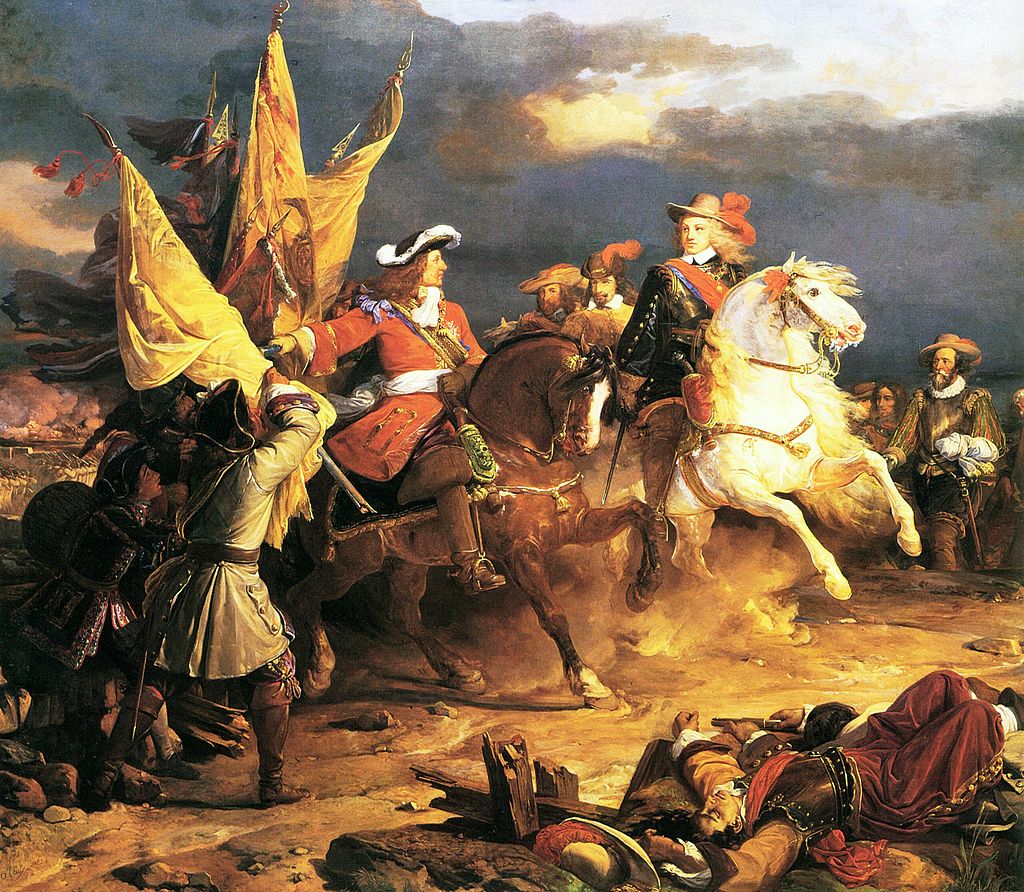
Philip V of Spain and the Duke of Vendôme pictured after the victory at the 1710 Battle of Villaviciosa

Philip V of Spain and the Duke of Vendôme pictured after the victory at the 1710 Battle of Villaviciosa
( Click image to enlarge)
Other fronts in 1710 produced little, but in Spain the dispute over who would rule in Madrid was finally settled. Due to Louis XIV withdrawing much of his army from Spain, Philip V took to the field bereft of French generals and troops. In contrast, Joseph I at last fully committed himself to the Iberian front, hoping to dispel Tory resentment of his reputed half-hearted prosecution of the war. Thus reinforced, Starhemberg and Stanhope defeated Villadarias and Philip V at the Battle of Almenar on 27 July 1710, followed by victory against de Bay (Villadarias' replacement) at the Battle of Saragossa on 20 August. The Allies had regained control of Aragon, and at the end of September Charles III entered Madrid, albeit to a hostile reception. With Barcelona, Madrid, and Saragossa in Allied hands Philip V's position looked precarious, but again they failed to secure the backing of the Spanish people; moreover, with the collapse of the Geertruidenberg talks Louis XIV could return to support his grandson. Vendôme passed through the Pyrenees and took control of the main Franco-Spanish army, while the Duke of Noailles attacked Catalonia from Roussillon. Facing this new threat and unwilling to winter in the hostile territories of Castile, Starhemberg retired eastward. Vendôme pursued, and on 8/9 December he captured Stanhope and the British rearguard at Brihuega. When Starhemberg turned the main army to offer assistance, Vendôme attacked him at Villaviciosa on the 10th. Although Starhemberg kept the field, the Allies were subsequently forced into a precipitous retreat back to Catalonia, reduced to the region between Tarragona, Igualada, and Barcelona, where they would largely remain till the end of the war.
HISTORY
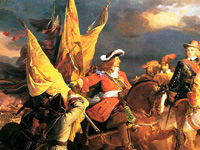
RESOURCES
This article uses material from the Wikipedia article "War of the Spanish Succession", which is released under the Creative Commons Attribution-Share-Alike License 3.0.
© Stories Preschool. All Rights Reserved.
